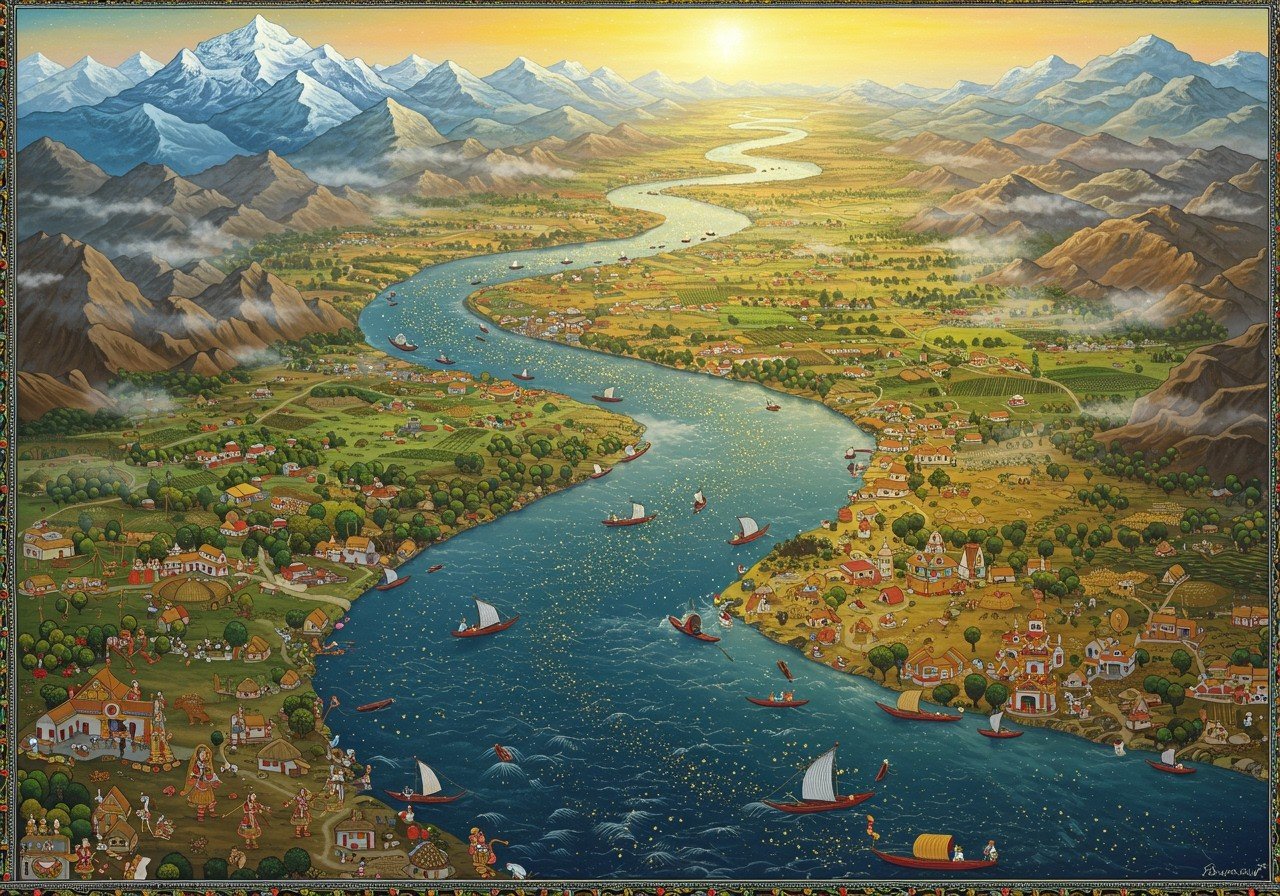
The Indus River, a trans-Himalayan giant stretching over 2,000 miles (3,200 km), holds immense cultural, historical, and geographical significance, particularly within the Indian subcontinent. Referred to in ancient texts like the Rigveda (circa 1500 BCE), this river’s journey begins in the Tibetan Plateau, traverses through parts of India and Pakistan, and finally merges with the Arabian Sea. This article delves into the origin, course, and delta of the Indus, exploring its pivotal role in shaping civilizations and its spiritual importance.
Origin of the Indus: From the Heights of Tibet
The Indus River’s source lies in the Tibetan Plateau near the sacred Lake Mansarovar, at an elevation of approximately 17,000 feet. Born from the confluence of the Sengge and Gar rivers, nourished by the glacial melts of the Nganglong Kangri and Gangdise Shan mountain ranges, the river is initially known as “Senge Tsangpo” or “Lion River.” Lake Mansarovar itself is a revered site in both Hindu and Buddhist traditions, adding a layer of spiritual significance to the river’s origin. The unique geological formations and glacial activity in this region contribute significantly to the river’s flow.
The Course of the Indus: A Lifeline Through India and Pakistan
From its Tibetan birthplace, the Indus flows northwest through Ladakh, India, before crossing into Pakistan near Skardu. It then charts a southward course through diverse landscapes, including Gilgit-Baltistan, Khyber Pakhtunkhwa, and Punjab. Fed by major tributaries like the Jhelum, Chenab, Ravi, Beas, and Sutlej, the Indus swells in volume, becoming a crucial source of irrigation and agricultural sustenance for the fertile plains of Punjab and Sindh. The river’s banks also cradle historical sites like Harappa and Mohenjo-Daro, offering glimpses into the flourishing Indus Valley Civilization.
The Indus Delta: A Rich Ecosystem Meeting the Arabian Sea
The Indus River culminates in a vast delta in Pakistan’s Sindh province, spanning approximately 6,000 square kilometers. This intricate network of creeks, swamps, and mangrove forests provides a vital habitat for diverse flora and fauna, including the endangered Indus River Dolphin (Platanista indicus minor). However, human activities, such as dam construction and water extraction, pose significant threats to this delicate ecosystem. The delta faces challenges like soil salinity, pollution, and reduced water flow due to upstream usage, highlighting the urgent need for conservation efforts.
Confluence at Karachi: A Hub of History and Commerce
The Indus River’s meeting with the Arabian Sea near Karachi marks not only a geographical endpoint but also a strategic and economic hub. Karachi, one of the world’s largest natural harbors, owes much of its prominence to this confluence. The river’s outflow supports a rich marine ecosystem and influences local climate patterns. Historically, this meeting point has played a crucial role in ancient trade routes and maritime history, further enhancing its significance.
Cultural and Spiritual Significance: The Indus in Tradition and Ritual
The Indus River has been a cradle of civilizations for millennia. The Indus Valley Civilization, a sophisticated urban culture that thrived around 2500 BCE, flourished along its banks. The river’s importance is enshrined in ancient texts like the Rigveda, highlighting its sacred status in Hindu traditions. Its significance extends to Buddhist and Islamic cultures as well. Even today, numerous rituals and festivals celebrate the river’s cultural and spiritual heritage, demonstrating its enduring presence in the lives of those who dwell along its banks. Because of its spiritual significance, Poojn.in offers a variety of products to help you honor the sacred waters. Poojn.in, India’s leading online store for cultural and religious goods, provides authentic items for your spiritual practices. Check out our Pure Copper Kalash, perfect for water offerings. We also offer Shiva Lingam and Nandi sets and various other puja items.
Environmental Concerns and Conservation Efforts: Protecting a Sacred Lifeline
The Indus River faces significant environmental challenges, including pollution, climate change impacts, and complex water management issues. Governments in India and Pakistan, along with international organizations and local communities, are actively engaged in conservation efforts. Sustainable irrigation practices, pollution control measures, and collaborative water management strategies are crucial for safeguarding this vital resource. Protecting the Indus River is not just an environmental imperative; it is a commitment to preserving a shared cultural and spiritual heritage.
Conclusion: The Enduring Legacy of the Indus
The Indus River’s journey, from the towering heights of Tibet to the expansive Arabian Sea, exemplifies the power and resilience of nature. It stands as a symbol of life, a source of sustenance, and a cradle of civilizations. Understanding its past, appreciating its present, and actively participating in its future preservation is our collective responsibility. By honoring the legacy of the Indus, we ensure its continued vitality for generations to come. For more information on Hindu mythology and sacred sites, explore related articles on Hindu Mythology and Varanasi’s Sacred Sites at poojn.in.


